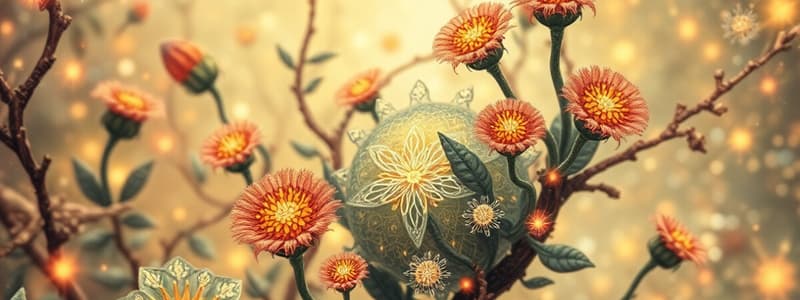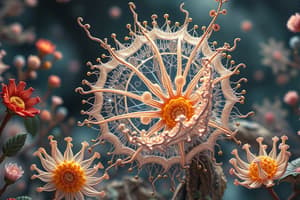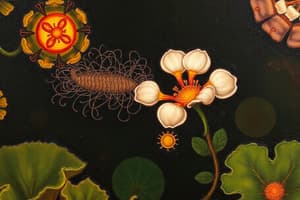Podcast
Questions and Answers
Which of the following is NOT a characteristic of living things?
Which of the following is NOT a characteristic of living things?
- Ability to think (correct)
- Made of cells
- Need energy
- Respond to the environment
Plants and animals obtain energy in the same way.
Plants and animals obtain energy in the same way.
False (B)
A membrane that is ____ allows only certain substances to pass through it.
A membrane that is ____ allows only certain substances to pass through it.
selectively permeable
What is the basic unit of life?
What is the basic unit of life?
The process by which plants collect energy from the sun to make their own food is called _____.
The process by which plants collect energy from the sun to make their own food is called _____.
Which of the following organelles is NOT found in a plant cell?
Which of the following organelles is NOT found in a plant cell?
Match the following organisms with their breathing structures:
Match the following organisms with their breathing structures:
Diffusion is the movement of molecules from an area of high concentration to an area of low concentration.
Diffusion is the movement of molecules from an area of high concentration to an area of low concentration.
What are the two main types of transport tissues found in plants, and what does each transport?
What are the two main types of transport tissues found in plants, and what does each transport?
Which of the following is an example of a stimulus and response in living things?
Which of the following is an example of a stimulus and response in living things?
You grow because your cells get bigger as you age.
You grow because your cells get bigger as you age.
Match the following cell organelles with their primary functions:
Match the following cell organelles with their primary functions:
What type of feet would a bird suited for swimming have?
What type of feet would a bird suited for swimming have?
The microscope magnifies_ the images of small objects.
The microscope magnifies_ the images of small objects.
On the lowest power objective lens, you should focus with which knob?
On the lowest power objective lens, you should focus with which knob?
What is the function of the gills in a fish?
What is the function of the gills in a fish?
On the medium and high power lenses, you should focus with which knob?
On the medium and high power lenses, you should focus with which knob?
A bird suited for eating insects hiding on tree bark would have a broad, flat beak.
A bird suited for eating insects hiding on tree bark would have a broad, flat beak.
When looking through a microscope, you should try to keep both eyes open.
When looking through a microscope, you should try to keep both eyes open.
Describe how you should safely carry a microscope.
Describe how you should safely carry a microscope.
Match the following cell organelles with their correct descriptions:
Match the following cell organelles with their correct descriptions:
What special organelles do Paramecium have that help them swim?
What special organelles do Paramecium have that help them swim?
What does an Amoeba use a pseudopod for?
What does an Amoeba use a pseudopod for?
Flashcards
Selectively Permeable
Selectively Permeable
A property of cell membranes that allows certain substances to pass while excluding others.
Tissue
Tissue
A group of similar cells working together to perform a specific function.
Organ
Organ
A structure made of different tissues that work together for a specific function.
Phloem
Phloem
Signup and view all the flashcards
Diffusion
Diffusion
Signup and view all the flashcards
Microscope
Microscope
Signup and view all the flashcards
Lowest Power Objective Knob
Lowest Power Objective Knob
Signup and view all the flashcards
Medium/High Power Objective Knob
Medium/High Power Objective Knob
Signup and view all the flashcards
Carrying a Microscope
Carrying a Microscope
Signup and view all the flashcards
Total Magnification Calculation
Total Magnification Calculation
Signup and view all the flashcards
Osmosis
Osmosis
Signup and view all the flashcards
Cilia in Paramecium
Cilia in Paramecium
Signup and view all the flashcards
Characteristics of Living Things
Characteristics of Living Things
Signup and view all the flashcards
Made of Cells
Made of Cells
Signup and view all the flashcards
Photosynthesis
Photosynthesis
Signup and view all the flashcards
Stimulus and Response
Stimulus and Response
Signup and view all the flashcards
Adaptations in Fish
Adaptations in Fish
Signup and view all the flashcards
Breathing Structures
Breathing Structures
Signup and view all the flashcards
Webbed Feet
Webbed Feet
Signup and view all the flashcards
Beak Types
Beak Types
Signup and view all the flashcards
Study Notes
Characteristics of Living Things
- Living things are made of cells
- They require energy
- They grow and develop
- They respond to their environment
- They adapt to their environment
- They reproduce
Basic Unit of Life
- Cells are the basic unit of life
Plant and Animal Energy
- Plants use photosynthesis to make their own food
- Animals get food from the environment
Stimulus and Response
- Sunlight coming through a window is a stimulus. A plant growing towards the window is a response
- A hot plate touching your hand is a stimulus. Quickly drawing your hand back is a response
- Unpredicted cold is a stimulus. Shivering from the cold is a response
Cell Growth
- You start as a single cell
- You grow because of more cells not larger cells
Fish Adaptations
- Fish have gills, fins, and scales for survival in water
Microscope Use
- The microscope magnifies small objects
- Use the coarse adjustment knob at low power
- Use fine adjustment at high power
- Carry the microscope with one hand on the base and the other on the arm
Keeping Eyes Open
- Keep both eyes open when looking at objects through a microscope
Cell Size
- Calculate cell size by measuring the total field of view and dividing by the number of cells that fit across, with the given total magnification value given.
- Example: 0.4 mm/5 cells = 0.08 mm per cell
Cell Organelles (Matching)
- Mitochondria: Powerhouse of the cell
- Golgi Complex: Packaging plant
- Cell Membrane: Selectively permeable
- Cell Wall: Found in plants; made of cellulose
- Cytoplasm: Fluid where chemical reactions occur
- Large Vacuole: Stores water\minerals
- Endoplasmic Reticulum: Transports proteins
- Ribosomes: Make proteins
- Chloroplasts: Site of photosynthesis
- Nucleus: Brain of the cell; holds DNA
- Organelles: Structure and function
Multicellular Organisms
- Paramecia use cilia to propel themselves
- Amoebas use pseudopods for movement and feeding
Diffusion and Osmosis
- Diffusion is the movement of substances from higher concentrations to lower ones
- Osmosis is the diffusion of water across a membrane
Selectively Permeable
- Selectively permeable membranes choose what can enter and exit the cell
- Membranes control the passage of materials
Cell Types
- Animal cells and plant cells differ in their presence or absence of certain organelles.
Tissues and Organs
- Similar cells combine to form tissue. Tissues can then combine to form organs.
Studying That Suits You
Use AI to generate personalized quizzes and flashcards to suit your learning preferences.




